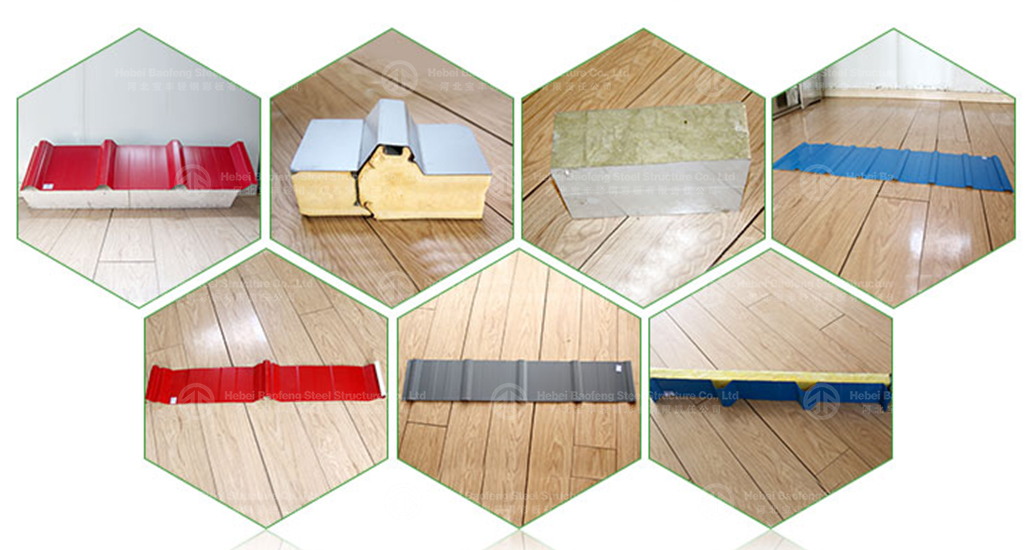
What are the advantages of sandwich panels for steel structure construction?
Sandwich panels are an integral component of modern steel structure construction, offering a wide range of advantages that make them a preferred choice for walls and roofs in industrial, commercial, and even agricultural buildings.
Here are the key advantages of using sandwich panels with steel structures:
1. Excellent Thermal Insulation and Energy Efficiency
Core Material: The insulated core (typically EPS, PU, Glass Wool or Rock Wool) has a very low thermal conductivity (U-value).
Reduced Energy Costs: This creates a highly effective thermal barrier, keeping buildings warm in winter and cool in summer. This significantly reduces the energy required for heating and ventilation (HVAC) systems, leading to substantial cost savings.
Condensation Control: By maintaining the interior surface temperature closer to the room temperature, they minimize the risk of condensation forming on the internal surfaces, which helps prevent corrosion of the steel frame and improves indoor air quality.
2. Rapid Construction and Installation (Speed of Build)
Large Panel Sizes: Sandwich panels are manufactured in large, single-piece sections that can cover vast areas quickly.
Simple Installation: They are lightweight and designed for easy and fast installation, often with simple concealed or visible fixing systems. This drastically reduces on-site labor time and costs compared to building up a wall system with separate cladding, insulation, and internal lining.
Weather Independent: The quick installation means the building envelope can be closed in faster, allowing interior work to begin sooner and protecting the structure from the elements.
3. Lightweight Nature
Reduced Dead Load: Despite their large size, sandwich panels are very lightweight. This places less load on the primary steel structure and foundations.
Cost Savings on Structure: The reduced load can lead to savings in the design of the supporting steel frame and foundations, as they don't need to be as heavy or robust.
4. High Strength and Durability
Composite Action: The two metal skins act as flanges and the core as a web, creating a structure similar to an I-beam. This gives the panels high strength and rigidity relative to their weight, making them resistant to wind and impact loads.
Long Lifespan: The external skins are typically made from galvanized steel or aluminum and are often coated with durable finishes (like PVDF or polyester) that are resistant to corrosion, fading, and weathering.
5. Aesthetic Appeal and Finish Variety
Clean, Modern Look: Sandwich panels provide a smooth, consistent, and modern appearance for buildings.
Customization: They are available in a vast array of colors, profiles (e.g., trapezoidal, micro-rib, flat), and surface finishes (metallic, matt, glossy). This allows for great design flexibility to meet architectural and branding requirements.
6. Fire Resistance
Varies by Core: The fire performance depends heavily on the core material.
Mineral Wool: Offers the best fire performance, being non-combustible (A2 or A1 fire rating) and providing excellent fire barriers.
PIR: Commonly has a Class B fire rating (good fire-retardant properties) and can be formulated to have low smoke development.
EPS: Is combustible and generally used where fire codes allow or require additional fire protection measures.
Compartmentalization: They can be used to create effective fire-rated compartments within a building.
7. Acoustic Insulation
Sound Dampening: The core material, especially mineral wool, provides good acoustic insulation. This helps in reducing the transmission of external noise (e.g., from rain, traffic, or industrial activity) into the building and can also contain noise generated inside, which is crucial for factories or facilities in noise-sensitive areas.
8. Low Maintenance
The durable, pre-finished surfaces require minimal maintenance. They are easy to clean (often just requiring water) and do not need periodic painting or sealing like traditional building materials.
9. Cost-Effectiveness
When considering the total cost—including materials, reduced structural costs, incredibly fast installation time, and long-term energy savings—sandwich panels offer a very competitive and often superior economic solution over traditional construction methods.

Categories
latest blog
Tags